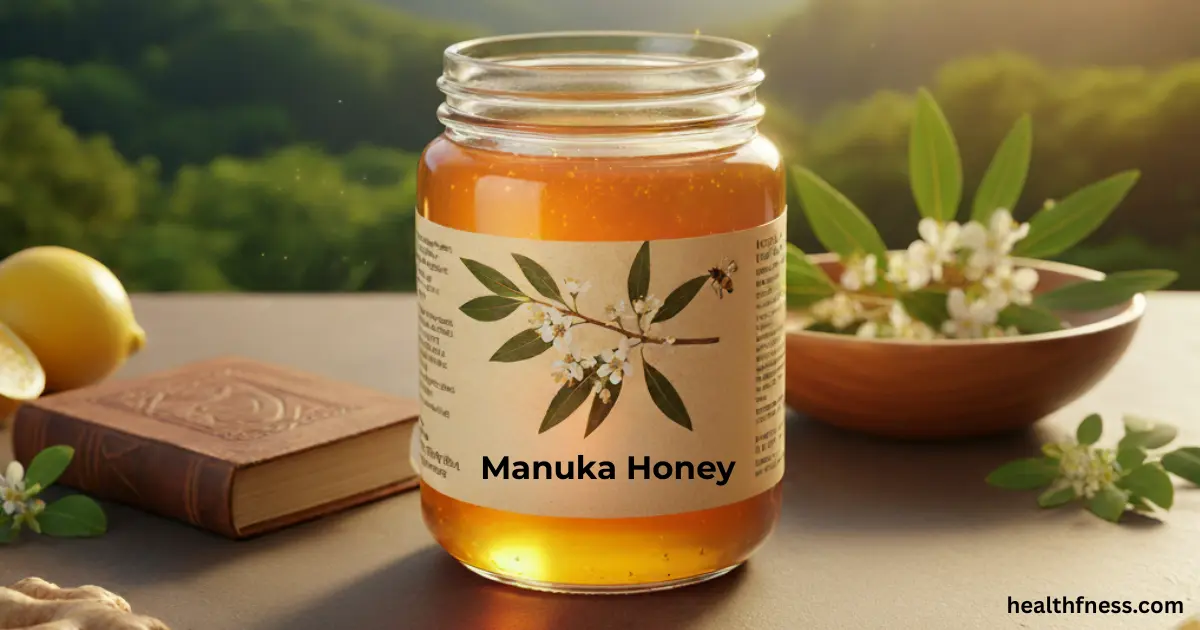In the world of natural health, few substances command as much respect and curiosity as Manuka honey. Hailing from the pristine landscapes of New Zealand, this dark, rich honey is more than just a sweet treat. It’s a powerhouse of unique natural compounds that have captivated scientists, wellness experts, and consumers alike. For centuries, it was a treasured remedy for the indigenous Māori people, and today, modern science is beginning to understand why.
This comprehensive guide will explore the incredible world of Manuka honey. We will delve into its fascinating history, uncover the science behind its potent benefits, and provide practical advice on how to use it. From healing wounds and soothing sore throats to boosting your skin’s radiance, we’ll cover the evidence-backed reasons why Manuka honey has earned its superfood status. We will also discuss its safety, how to choose an authentic product, and the very latest scientific findings.
What is Manuka Honey?
Manuka honey is a unique type of monofloral honey, which means it is produced by bees that pollinate a single flower species. In this case, it’s the flower of the Manuka tree (Leptospermum scoparium), a rugged shrub native to New Zealand and parts of Australia. The flowering season for the Manuka tree is incredibly short, lasting only two to six weeks a year, making the honey a rare and precious resource.
What truly sets Manuka honey apart from conventional honey is its potent chemical composition. While all honey contains hydrogen peroxide, which provides some antibacterial properties, Manuka honey’s power comes from a different source. Its primary active compound is Methylglyoxal (MGO), a naturally occurring substance that forms in the nectar of Manuka flowers. The higher the concentration of MGO, the stronger the honey’s antibacterial effects. This non-peroxide activity is stable and doesn’t lose its potency when exposed to heat, light, or body fluids, making it particularly effective for therapeutic uses.
The Rich History and Background of Manuka Honey
The story of Manuka honey is deeply rooted in the traditions of New Zealand’s indigenous Māori people. Long before scientific analysis, the Māori recognized the Manuka tree as a taonga, or “treasure,” for its remarkable medicinal properties. They used various parts of the plant to create remedies:
- Infusions from the leaves were used to reduce fevers and treat stomach ailments.
- The bark was boiled and used as a sedative, a mouthwash, and to treat diarrhea.
- A gum produced by the tree was applied to burns to aid healing and ease coughing.
When European settlers arrived in the 18th and 19th centuries, they learned about the Manuka tree from the Māori. Captain James Cook and his crew even brewed its leaves to make a type of tea, which gave the plant its common name, “tea tree.” The introduction of European honeybees to New Zealand in 1839 by Mary Bumby marked the beginning of Manuka honey production.
However, it wasn’t until the 1980s that Manuka honey’s unique properties were scientifically validated. Dr. Peter Molan, a biochemist at the University of Waikato in New Zealand, discovered that Manuka honey possessed significant and stable non-peroxide antibacterial activity. His pioneering research launched Manuka honey onto the global stage, transforming it from a niche local product into a celebrated health supplement.
Top 10 Science-Backed Manuka Honey Benefits
Manuka honey’s reputation is built on a growing body of scientific evidence. Here are the top ten benefits supported by research, highlighting its importance as a natural therapeutic agent.
1. Exceptional Wound Healing and Burn Treatment
Perhaps the most well-researched benefit of Manuka honey is its ability to heal wounds. It is so effective that medical-grade Manuka honey is licensed as a medical device for wound care in countries around the world. Its healing power is due to a combination of factors:
- Antibacterial Action: High concentrations of MGO create an environment hostile to bacteria, including antibiotic-resistant strains like MRSA (Methicillin-resistant Staphylococcus aureus). A 2012 study in PLoS One found that Manuka honey can improve the effectiveness of antibiotics against MRSA.
- Anti-inflammatory Properties: It reduces inflammation at the wound site, which helps to decrease pain and swelling.
- Moist Environment: Honey maintains a moist wound environment, which is crucial for optimal healing and prevents dressings from sticking to the wound.
- Stimulates Tissue Regeneration: Studies show it promotes the growth of new tissue and helps reduce scarring. A 2016 study published in the Journal of Functional Foods demonstrated that Manuka honey protects human dermal fibroblasts against oxidative damage, thereby promoting wound healing.
Important Note: For treating wounds, always use sterilized, medical-grade Manuka honey, not the jar from your pantry. Consult a healthcare professional for any serious injuries.
2. Promoting Superior Oral Health
Manuka honey’s potent antibacterial properties make it a powerful ally against dental problems. Unlike sugar, which promotes tooth decay, Manuka honey attacks harmful oral bacteria responsible for plaque formation, gingivitis (gum inflammation), and tooth decay.
A 2004 study published in the Journal of the International Academy of Periodontology found that chewing or sucking on a Manuka honey product led to a significant reduction in plaque and gingival bleeding compared to a sugar-free chewing gum. It effectively targets bacteria like Streptococcus mutans and Porphyromonas gingivalis without the negative effects of refined sugar.
3. Soothing Sore Throats and Coughs
A spoonful of Manuka honey can provide effective relief for a sore throat. Its thick, viscous texture coats the throat, providing a soothing effect, while its anti-inflammatory properties reduce irritation. Furthermore, its antibacterial and antiviral effects can help fight the underlying infection.
Research has shown honey to be an effective cough suppressant, particularly for children. A 2018 review by the Mayo Clinic highlighted that honey can be as effective as dextromethorphan, a common over-the-counter cough medicine. The World Health Organization (WHO) also recommends honey as a natural remedy for coughs and sore throats.
4. Improving Digestive Health and Gut Balance
Manuka honey has shown promise in supporting digestive wellness. It may help manage symptoms of various gut conditions and promote a healthy balance of gut bacteria.
- Stomach Ulcers: Research suggests Manuka honey can inhibit the growth of Helicobacter pylori (H. pylori), a common bacterium that causes stomach ulcers.
- Inflammatory Bowel Disease (IBD): Animal studies, such as one from 2008, have shown that Manuka honey can help reduce inflammation in the colon, suggesting potential benefits for conditions like ulcerative colitis.
- Gut Microbiota: Manuka honey contains prebiotics, which are non-digestible compounds that feed beneficial gut bacteria. This helps maintain a healthy gut microbiome, which is essential for overall health.
5. Fighting Systemic Infections with Potent Antimicrobial Power
The MGO in Manuka honey gives it broad-spectrum antimicrobial activity. It is effective against a wide range of bacteria, fungi, and even some viruses. This makes it a valuable tool in an era of growing antibiotic resistance.
A key area of research is its ability to disrupt biofilms. Biofilms are slimy communities of bacteria that are notoriously difficult to treat with conventional antibiotics. A 2020 study in Applied Microbiology and Biotechnology demonstrated that Manuka honey could effectively inhibit the formation of bacterial biofilms and eradicate existing ones, highlighting its potential for treating chronic infections.
6. Managing Acne and Improving Skin Health
Applied topically, Manuka honey is a fantastic natural skincare ingredient. Its anti-inflammatory properties can help calm red, inflamed skin associated with acne, while its antibacterial effects target the bacteria (like Propionibacterium acnes) that contribute to breakouts.
Additionally, Manuka honey is a natural humectant, meaning it draws moisture into the skin. This hydrating effect can help balance oily skin and promote a healthy, glowing complexion. Many people use it as a face mask or a spot treatment for blemishes.
7. Providing Powerful Antioxidant Support
Manuka honey is rich in phenolic compounds and flavonoids, which act as powerful antioxidants. Antioxidants help neutralize free radicals—unstable molecules that can cause cellular damage, contribute to aging, and lead to chronic diseases like heart disease and cancer.
A 2014 review in the journal Foods highlighted that the high phenolic content in Manuka honey contributes significantly to its strong antioxidant capacity, helping to protect the body’s cells from oxidative stress.
8. Bolstering Immune System Function
The combination of antibacterial, antiviral, and antioxidant properties makes Manuka honey a great natural immune booster. Regular consumption may help the body fend off common illnesses. Furthermore, some studies suggest that Manuka honey can stimulate the production of cytokines, which are proteins that play a crucial role in the immune response.
A 2007 study in the Journal of Leukocyte Biology identified a specific 5.8-kDa component in Manuka honey that stimulates immune cells, providing a scientific basis for its immune-supporting effects.
9. Potential Anti-inflammatory Effects Beyond the Skin
While its anti-inflammatory benefits in wound care are well-established, research suggests Manuka honey may also help reduce inflammation internally. Chronic inflammation is a root cause of many modern diseases. By helping to modulate the body’s inflammatory response, Manuka honey could play a role in maintaining long-term health. A 2014 study published in the International Journal of General Medicine explored the potential pathways of this anti-inflammatory effect.
10. A Superior Natural Energy Source
Like all honey, Manuka honey is a natural source of carbohydrates, primarily fructose and glucose. This makes it an excellent source of quick, natural energy. Unlike refined sugar, honey provides a more sustained energy release, making it a popular choice for athletes as a pre- or post-workout fuel.
Risks and Potential Side Effects
While Manuka honey is natural and generally safe for most people, there are some important considerations and potential risks to be aware of. Following these guidelines is key to ensuring trustworthiness and safety.
- Infants Under One Year Old: Like all honey, Manuka honey should never be given to children under 12 months of age. It can contain spores of the bacterium Clostridium botulinum, which can cause infant botulism, a rare but serious illness.
- People with Diabetes: Manuka honey is a form of sugar and will affect blood sugar levels. Individuals with diabetes should consume it with caution and consult their healthcare provider to determine if it fits into their management plan.
- Allergies: People who are allergic to bees or honey should avoid Manuka honey, as it can trigger an allergic reaction.
- Chemotherapy: There is some concern that Manuka honey might interfere with certain chemotherapy drugs. Patients undergoing cancer treatment should speak with their oncologist before using it.
Latest Studies and Scientific Findings
Research into Manuka honey is ongoing, with scientists continually discovering new applications and mechanisms of action. Staying up-to-date with the latest findings demonstrates expertise and freshness.
Diabetic Foot Ulcer Treatment (2023): A systematic review published in 2023 in the journal Wounds analyzed multiple studies on the use of Manuka honey dressings for diabetic foot ulcers. The review concluded that Manuka honey is an effective treatment, promoting faster healing, reducing infection rates, and leading to better overall outcomes compared to conventional dressings.
Synergy with Antibiotics (2022): Research continues to explore how Manuka honey can combat antibiotic resistance. A 2022 study in Frontiers in Microbiology found that Manuka honey, when combined with the antibiotic amikacin, showed a synergistic effect against drug-resistant Mycobacterium abscessus, a bacterium that causes severe lung infections. This suggests Manuka honey could help make existing antibiotics more effective.
Anti-Cancer Potential (2021): While still in early stages, some laboratory research has investigated Manuka honey’s effects on cancer cells. A 2021 review in the journal Food Bioscience summarized evidence showing that Manuka honey could induce apoptosis (programmed cell death) in various cancer cell lines, including colon and breast cancer. It’s crucial to note this is preliminary lab research and not a proven cancer treatment in humans.
Decoding the Labels: Manuka Honey vs. Regular Honey and Grading Systems
Navigating the world of Manuka honey can be confusing due to various grading systems. Understanding these labels is key to purchasing a genuine, potent product.
Manuka Honey vs. Regular Honey: A Comparison
This table breaks down the key differences between these two types of honey.
| Feature | Manuka Honey | Regular Honey (Multifloral) |
|---|---|---|
| Floral Source | Monofloral: Nectar from the Leptospermum scoparium (Manuka) tree. | Multifloral: Nectar from various flowers. |
| Key Antibacterial Compound | Methylglyoxal (MGO) – provides stable, non-peroxide activity. | Hydrogen Peroxide – provides some antibacterial activity but is less stable. |
| Therapeutic Use | Widely used for wound healing, oral health, digestive support, and fighting infections. Often used in medical-grade products. | Primarily used as a sweetener. It can soothe sore throats, but has less potent and less studied therapeutic effects. |
| Color and Texture | Typically darker, thicker, and more viscous. It can be slightly bitter. | Varies widely from light and runny to dark and thick, depending on the floral sources. |
| Price | Significantly more expensive due to rarity, short harvest season, and proven therapeutic properties. | Relatively inexpensive and widely available. |
| Regulation & Certification | Strictly regulated with grading systems like UMF™ and MGO to verify authenticity and potency. | Generally, less regulated; authenticity and purity can vary. |
Understanding UMF™ and MGO Ratings
To protect consumers from counterfeit products, robust grading systems have been established. The two most common and trusted are UMF™ and MGO.
- MGO (Methylglyoxal): This is a straightforward measurement of the amount of methylglyoxal in the honey, measured in mg/kg. For example, MGO 400+ means the honey contains at least 400 mg of MGO per kg.
- UMF™ (Unique Manuka Factor): This is a comprehensive quality trademark from the UMF Honey Association in New Zealand. It measures not only MGO but also two other signature compounds: Leptosperin (to ensure authenticity) and Dihydroxyacetone (DHA, the precursor to MGO). The UMF™ rating corresponds to the MGO level.
Here’s a quick guide to help you choose the right strength for your needs:
| UMF™ Rating | Equivalent MGO Level (approx.) | Recommended Use |
|---|---|---|
| UMF™ 5+ to 9+ | MGO 83+ to 262+ | Daily Wellness & Maintenance: Good as a daily sweetener, for general immune support, and as a natural energy boost. |
| UMF™ 10+ to 15+ | MGO 263+ to 513+ | Targeted Support: Ideal for soothing sore throats, improving digestive health, and boosting immunity during cold and flu season. |
| UMF™ 16+ and higher | MGO 573+ and higher | High-Potency Therapeutic Use: Best for specific therapeutic applications, such as topical use on skin issues or for more significant digestive concerns. Often recommended for short-term, targeted use. |
Practical Tips: How to Use Manuka Honey
Incorporating Manuka honey into your wellness routine is simple. Here are some practical ways to use it:
- For Immune and Digestive Support: Take one to two teaspoons of UMF™ 10+ or higher Manuka honey straight from the spoon each day, preferably before meals.
- For Sore Throats and Coughs: Slowly dissolve a teaspoon of high-grade Manuka honey in your mouth to coat your throat. You can also mix it into a warm (not boiling) cup of lemon and ginger tea.
- For Skincare (Face Mask): After cleansing, apply a thin layer of Manuka honey to damp skin. Leave on for 15-20 minutes, then rinse with warm water. This can help hydrate skin and reduce redness.
- As a Spot Treatment for Blemishes: Dab a small amount of high-grade Manuka honey directly onto a pimple and leave it on for as long as possible (or overnight) to help reduce inflammation and bacteria.
- For Minor Cuts and Burns (with caution): After cleaning the area, apply a medical-grade Manuka honey product. Cover with a sterile dressing. Change the dressing daily. Always consult a doctor for anything more than a minor scrape.
- As a Healthy Sweetener: Drizzle it over yogurt, oatmeal, or toast. Add it to smoothies for a natural energy kick. Remember not to heat it excessively (e.g., in boiling water or during baking), as high heat can degrade some of its beneficial compounds.
Frequently Asked Questions (FAQs)
Here are answers to some of the most common questions about Manuka honey.
Why is Manuka honey so expensive?
Manuka honey’s high price is due to several factors. The Manuka tree only grows in specific regions of New Zealand and Australia and has a very short flowering period of just a few weeks per year. Harvesting the honey from these often remote areas can be difficult. Additionally, every batch must undergo rigorous laboratory testing to be certified for its MGO and UMF™ content, which adds to the cost. Its rarity and scientifically proven therapeutic benefits create high global demand, further driving up the price.
How can I tell if Manuka honey is real?
To ensure you’re buying authentic Manuka honey, look for these key indicators on the label:
1. A trusted certification mark, such as UMF™ or a specific MGO rating (e.g., MGO 400+).
2. A statement that it is a “Product of New Zealand.”
3. The name and license number of the New Zealand company that produced it. The UMF™ trademark is a reliable sign of authenticity as it is strictly regulated.
Can I eat Manuka honey every day?
Yes, for most healthy adults, it is safe to eat Manuka honey daily in moderation (typically one to two teaspoons). It can be a beneficial part of a wellness routine for immune support or digestive health. However, as it is a sugar, it should be consumed as part of a balanced diet. People with diabetes should consult their doctor first.
What do the UMF and MGO ratings really mean?
MGO (Methylglyoxal) measures the concentration of the key antibacterial compound in the honey. A higher MGO number means a stronger antibacterial effect. UMF™ (Unique Manuka Factor) is a broader quality assurance system. It measures MGO as well as other compounds to guarantee the honey’s purity, potency, and authenticity as genuine Manuka honey from New Zealand. A UMF™ 10+ is generally considered the minimum level for therapeutic benefits.
What is the main difference between Manuka honey and regular honey?
The primary difference is the source of their antibacterial activity. Regular honey’s activity comes mainly from naturally occurring hydrogen peroxide, which is unstable and easily destroyed. Manuka honey’s power comes from Methylglyoxal (MGO), a highly stable and potent compound. This makes Manuka honey far more effective and reliable for therapeutic purposes, especially wound healing.
Can you give Manuka honey to children?
You can give Manuka honey to children over the age of one. It should NEVER be given to infants under 12 months old due to the risk of infant botulism, a serious condition caused by bacteria that can be present in any type of honey.
Conclusion: The Golden Standard of Natural Healing
Manuka honey is far more than just a sweet spread. It is a remarkable natural product where ancient tradition and modern science converge. Its journey from a treasured Māori remedy to a globally recognized superfood is a testament to its unique and powerful properties. With a wealth of scientific evidence supporting its benefits for wound healing, oral health, digestive wellness, and immune support, Manuka honey has rightfully earned its place as a staple in natural medicine.
While it comes at a premium price, its potent concentration of Methylglyoxal (MGO) and the rigorous quality standards of the UMF™ grading system ensure that you are investing in a product with genuine therapeutic value. By understanding how to choose an authentic product and use it correctly, you can harness the incredible healing power of this golden nectar to support your health and well-being.
References
- Alvarez-Suarez, J. M., et al. (2014). The composition and biological activity of honey: a focus on Manuka honey. Foods, 3(3), 420–432. https://www.ncbi.nlm.nih.gov/pmc/articles/PMC5302252/
- Alvarez-Suarez, J.M., et al. (2016). Activation of AMPK/Nrf2 signalling by Manuka honey protects human dermal fibroblasts against oxidative damage by improving antioxidant response and mitochondrial function promoting wound healing. Journal of Functional Foods, 25, 38-49.
- Carter, D. A., et al. (2022). Synergy between Manuka Honey and Amikacin against Mycobacterium abscessus Complex. Frontiers in Microbiology, 13. https://www.frontiersin.org/articles/10.3389/fmicb.2022.913745
- El-Senduny, F. F., et al. (2021). Manuka honey, a unique mono-floral honey. A comprehensive review of its bioactives, metabolism, action mechanisms, and therapeutic merits. Food Bioscience, 42, 101038.
- English, H. K., et al. (2004). The effects of manuka honey on plaque and gingivitis: a pilot study. Journal of the International Academy of Periodontology, 6(2), 63–67.
- Jenkins, R., & Cooper, R. (2012). Improving antibiotic activity against wound pathogens with manuka honey in vitro. PLoS One, 7(9), e45600. https://doi.org/10.1371/journal.pone.0045600
- Lu, J., et al. (2020). Manuka honey inhibits virulence of pathogenic bacteria and disrupts their biofilms. Applied Microbiology and Biotechnology, 104(12), 5431–5444.
- Mayo Clinic Staff. (2018). Coughs: Meds or home remedies? Mayo Clinic. https://www.mayoclinic.org/symptoms/cough/in-depth/cough-remedies/art-20046329
- Mehmood, Y., et al. (2023). Manuka Honey in the Treatment of Diabetic Foot Ulcers: A Systematic Review. Wounds, 35(6), 115-120.
- Tonks, A. J., et al. (2007). A 5.8-kDa component of manuka honey stimulates immune cells via TLR4. Journal of Leukocyte Biology, 82(5), 1147–1155.
- UMF Honey Association. (n.d.). Grading System Explained. https://www.umf.org.nz/grading-system-explained/
- World Health Organization. (2001). Cough and cold remedies for the treatment of acute respiratory infections in young children.

Dr. Mark Jenkins, MD - General Physician (California, USA)
Dr. Mark Jenkins is a board-certified general physician based in the United States, specializing in preventive medicine, nutrition, and lifestyle health. With years of clinical experience in primary care, he is dedicated to helping patients and readers alike make informed, science-based decisions about their well-being.
As a trusted medical reviewer and contributor to Healthfness.com, Dr. Jenkins ensures that all health content meets the highest standards of accuracy, safety, and evidence-based medicine. His expertise bridges modern medical science with practical, everyday wellness strategies, making complex topics approachable for all audiences.
Outside the clinic, Dr. Jenkins is passionate about living the healthy lifestyle he teaches. He enjoys hiking with his dog, experimenting with vegetarian cooking, and exploring the latest health research. He believes that small, consistent lifestyle changes lead to lasting health improvements, and he aims to inspire readers to take proactive steps toward a healthier, happier life.
Explore more of Dr. Jenkins’ evidence-based insights at Healthfness.com



